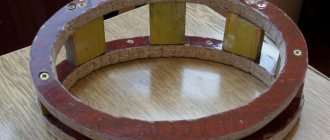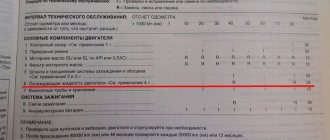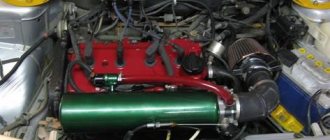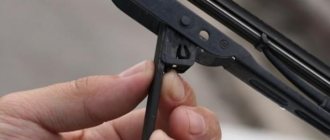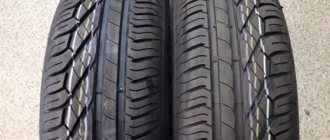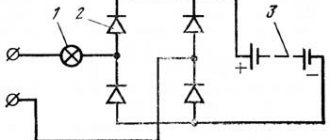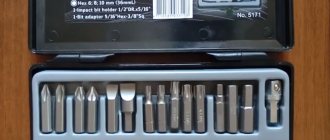How to change a wheel
The wheels, as always, break at the most inopportune moment.
Therefore, you must always be prepared for this trouble. I think there is no point in saying that there should be a working and inflated spare tire in the trunk. Driver's actions to change a wheel:
- Block the car's wheels to prevent it from moving.
- If the car wheels are equipped with hubcaps, then using a screwdriver or the flat end of a wheelbrace, you need to pry and remove the hubcap from the damaged wheel.
- Remove the spare tire from the trunk of the car.
- Using a wheel wrench, loosen the mounting bolts that hold the wheel. In this case, you need to know which bolts you have - left-handed or right-handed. The type of thread determines which direction the wrench should be turned. Typically, right-hand threaded bolts (which should be unscrewed counterclockwise) are used, but sometimes, on the left side of the vehicle there may be left-hand threaded bolts (which should be unscrewed clockwise). Look carefully at the bolts - if the letters “R” and “L” are visible in the center of the bolt, then: R (right) – right-hand thread; L (left) – left-hand thread.
- Place the wheel wrench on the bolt and loosen it until it can be turned freely by hand. Do this operation in a circle with all the bolts. The bolts can be very tight, so if you can't loosen it with your hands, you can use your feet or improvised means (a piece of pipe) to increase the strength or length of the lever.
- Place the jack in its designated location and lift the car so that the wheel rotates freely in the air.
- Install supports and lower the car onto them (the wheel should still rotate freely).
- Unscrew the loosened bolts by hand and remove the broken wheel from the studs.
- Roll the broken tire to the trunk and put it in place of the spare wheel.
- Place the spare tire on the studs and secure it with the bolts.
- Lightly tighten the bolts with a wheel wrench until the wheel is securely in place.
- Raise the car on a jack and remove the jack stands.
- Lower the car to the ground and remove the jack.
- BE SURE to tighten all the wheel bolts! Pull with all your strength - don’t be afraid, you won’t break the thread, but the wheel will be securely fixed.
- Reinstall the wheel cover. To do this, place it opposite the hooks and drive it into place with the back of your hand. Tap it a couple of times in several places to make sure it sits evenly and securely. If this cannot be done, then this can be done later. The cap mainly plays a decorative role, and it is quite possible to drive without it. But it is highly recommended to install the cap in the near future, because... it protects the brake pads and bearings from dirt and dust.
- Don't forget to take all tools and wheel blocking chocks with you.
- Don’t delay repairing a flat tire, otherwise if you have another accident, you will have nothing to replace the flat tire with. A broken tire can be repaired at any tire shop. Depending on the damage, the technician will offer you repair options.
Top of page
Source: vaz-2101-07.ru
How to unscrew a bolt: 45 practical recommendations
How to unscrew a bolt? An article about effective methods with an overview of the best and non-standard tools.
In this material we will look at how to unscrew a torn bolt (with torn edges), a rusted bolt, a crankshaft pulley bolt, a wheel, an exhaust manifold, a cylinder head and other components and assemblies.
The recommendations will also be useful in household work - when repairing faucets, toilets, garage equipment, prefabricated buildings, etc.
How to unscrew a bolt
Bolts are usually unscrewed with spanners or open-end wrenches, screwdrivers, sockets using a wrench, ratchet or pneumatic impact wrench. However, other options are also possible.
Before unscrewing the bolt, from the available tool you need to choose the one that suits best:
- thin short open-end wrenches, especially with a too loose (broken) jaw, are the worst option, which is better to immediately abandon in a situation with unscrewing rusty stuck bolts (this will lead to torn edges);
- ring wrenches are preferable to open-end wrenches, since they cover the perimeter of the bolt head more tightly;
- A 6-point socket wrench or socket is preferable to their 12-point versions, since hex ones have a larger area of pressure on the flat working surfaces of the head and are less likely to tear off the edges;
- a tool with an extended handle or additional attachment is preferable to a short one;
- Due to its simplicity and strength, a crank is preferable to a ratchet, because for the latter, the application of increased forces can lead to damage to the mechanism (this is especially true for ratchets with a large number of teeth, each of which is smaller and not so durable);
- an air impact wrench is better than a hand tool;
- in combination with a wrench or an air impact wrench, the best solution would be the Super Lock head, in which the force is applied not to the corners (edges), but to the planes, which prevents the edges of the bolt head from being licked off;
- a torque amplifier (multiplier) will help apply a force to a large stuck bolt that exceeds human physical capabilities;
- a screwdriver with a large handle of a typical shape or a T-shaped power one will do a better job than traditional compact versions;
- a suitable clamping tool (pipe (“gas”), wrench, clamp, vice, pliers, etc.) will be useful in the absence of keys or when the edges are licked;
- if the head height is sufficient, in rare cases a pin driver of the appropriate size can be used.
Read more: How does chip tuning affect engine life?
Further, when describing the methods, we will show how to unscrew a bolt from an atypical tool.
It is worth purchasing a durable Super Lock socket for wheel bolts and carrying it with you in the car at all times, since wheel fasteners often get damaged during seasonal tire changes and can cause serious difficulties for the car owner on the road in the event of a puncture.
Which way to unscrew the bolt?
Most often, bolts with right-hand threads are used: they need to be unscrewed counterclockwise (look at the bolt from the head side). Unscrew the bolt with left-hand thread clockwise.
When deciding which way to unscrew the bolt, just look at it carefully:
- on the side you can see the inclination of the bolt threads at a small angle - unscrew the bolt in the direction in which the thread “rises”;
- even if the threaded thread is not visible, you can determine the direction from the end of the nut (or the through threaded channel in which the bolt sits) at the point where the last turn of its internal thread exits.
In the absence of visible signs, when only the cap pressed tightly to the surface of the part is visible, it is better to start unscrewing counterclockwise; if there is no result, then try counterclockwise.
How to unscrew a broken bolt
A bolt with torn edges can be unscrewed in several basic ways: ·
- use a Super Lock head, which acts on planes and not on edges;
- hold the torn bolt in a pipe wrench (in a vice, clamp, pliers, etc.) and unscrew it;
- make a cut in the head and unscrew it with a powerful screwdriver;
- combine the two previous methods, using both a clamping tool and a screwdriver, which will allow you to apply the force of two hands;
- grind the cap to a smaller size;
- use a special tool - an extractor (similar to a tap, the working part is conical, the thread direction is opposite to the thread of the stud): drill a hole in the center of the required diameter and depth, approximately 2/3 of the length of the working part of the extractor, insert the extractor and rotate with force until the bolt is unscrewed;
- drill a hole in the center of the cap no deeper than the height of the cap, drive a TORX nozzle (E-profile, or another similar one with longitudinal ribs) into it and unscrew it by the shank of the nozzle;
- hammer a suitable larger nut on top of the head of the bolt with licked edges, the inner diameter of which allows it to be tightly seated, for additional fixation, drill a recess in the contact area of the nuts, insert a suitable metal rod there as a key to prevent rotation, unscrew the bolt using tool to size nut of larger diameter;
- put on a nut of larger diameter and weld it to the head of the bolt using a semi-automatic welding machine, unscrew the large nut together with the bolt welded to it.
As you can see, unscrewing a bolt with torn edges is not so difficult.
How to unscrew a broken bolt
Information on how to unscrew a broken bolt that does not have a head can be obtained from the article “How to unscrew a hairpin: 25 effective methods and techniques,” which is posted in the “Useful” section on ZiSinfo.rf.
How to unscrew a rusty bolt
It is easier to unscrew a rusty bolt if you have access to the threaded part. As a rule, such an opportunity exists from the side of the end on which the nut is screwed (the bolt passes through the parts being fastened), less often - from the side of the head, when it does not fit tightly to the surface being fastened. You must proceed as follows: ·
- accessible threads must be thoroughly cleaned of rust with a wire brush and dirt must be removed;
- Apply the penetrating compound WD-40, “Liquid Key” and their analogues to the threads (so that the applied compound flows from top to bottom into the thread sticking zone of the rusty bolt), let the compound work for 20 minutes, unless a different time is specified by the manufacturer of the product;
- using the available tool, apply force in the direction of unscrewing;
- if the bolt does not give in, then use the walking method, alternately applying force to both tightening and tightening;
- if these actions do not lead to a positive result, then apply soaking in a penetrating or chemically active preparation against rust for a long time.
Read more: Adjusting the Pirburg 2e3 carburetor
How to unscrew a bolt with soaking
The essence of the method is to expose the rusty threaded part of the bolt to a penetrating or chemically active composition against rust for a sufficiently long time.
- generously moisten the rusty fasteners in the thread area with the active agent, wrap the accessible threaded shank of the bolt with a rag soaked in this agent or place it on top (so that the chemical flows down the thread from top to bottom), close tightly to prevent drying, if necessary, adding fresh agent every few hours;
- Immerse the fasteners completely in the chemical, using a large volume of it in a suitable container.
The following can be used as a means for soaking rusty fasteners:
- special penetrating compounds WD-40, “Liquid Key” and analogues;
- kerosene, gasoline, carburetor cleaner, lock defroster, brake fluid and others, from garage stock;
- rust converter;
- compounds that are chemically active against rust - table vinegar, iodine, Coca-Cola, etc.
How to unscrew a stuck bolt
Before unscrewing a stuck bolt, you need to perform preparatory steps that can make things easier:
- hit the head with a hammer along the axis of the bolt;
- apply rocking tapping with a hammer on the lateral working planes around the circumference of the bolt head;
- if possible, heat the fastened part in the area of the threaded channel and try to unscrew it while it’s hot (if it doesn’t help the first time, then repeat the heating several times).
In the latter case, for heating you can use matches, a wax candle, a lighter, a gas canister burner, a blowtorch or a gas cutter (the latter very carefully, at a sufficient distance so as not to damage the part).
You can unscrew a bolt that does not want to unscrew, if it is stuck, by using penetrating lubricant in combination with other methods of increasing force.
How to unscrew a bolt without a screwdriver
If the bolt head is suitable for a screwdriver, but you don’t have one at hand, then the following options are possible:
- clamp the bolt head in a vice, pliers, clamping pliers or other similar tool or a bit from the available set;
- if there is no Phillips or other shaped bit, then use the method of cutting the head for a flat screwdriver or turning the head on a turnkey basis (grind the opposite sides of the head with a file, burr or grinder until parallel planes of sufficient area are formed);
- if you don’t have a flat-head screwdriver or a bit, use any suitable or specially turned to size object made of hardened steel - clamped in the tool listed above, it will act as a screwdriver blade;
- with a massive bolt head, you can use methods with fastening by welding or on the key of a large nut, or by another suitable method described above.
How and with what to unscrew an asterisk or hex bolt without a key
Often a star or hex bolt has a round head. How and with what to unscrew a bolt without a key? You can consider any of the suitable methods indicated above for unscrewing bolts with torn edges.
How to unscrew a hard-to-reach bolt
Before unscrewing a hard-to-reach bolt, you need to prepare a special tool:
- wrench or ratchet with a short handle;
- ratchet with a large number of teeth in the mechanism (gives a small angle of rotation, which is important in cramped conditions);
- extensions to heads;
- cardans;
- flexible drives for heads.
If you plan to regularly work with hard-to-reach fasteners, then it is better to buy the listed tool, as part of a set or individually for actual tasks. For a one-time use, you can ask for what you need for a while.
Before unscrewing the bolt, it is necessary to clean the threaded part from rust and contaminants, apply a penetrating or chemically active composition against rust, select from the available tool what will fit best and only then apply force.
Using excessive force and using the wrong tool will most likely result in damage to the bolt head or broken bolt or tool.
When considering how to unscrew a bolt, immediately choose the most effective and reliable solution available.
see also
How to check the hub
- 37 0 22k
Wheel bearing grease
- 112 4 125k
Wheel bearing
- 28 0 42k
Hub
- 0 1 69k
Car brake system maintenance
- 20 0 65k
Many will agree that unscrewing the hub nut is an activity that can be punished in court; it is too inconvenient and difficult even for a physically strong person with all the necessary tools. However, since it is not always possible to choose the easiest one (option One, also known as the Main one!) - sending the car to a service station, where they will not only unscrew it but also carry out subsequent repairs. Then you will have to figure out the task yourself, using the easiest and most effective method possible.
Which way does the hub nut unscrew?
Yes, you may very well be one of the lucky ones who won't need any extra effort as the problem with unscrewing the hub nut may simply be a matter of going in the wrong direction.
So, we take the wrench and, when your car is far from new, try, if the nut does not lock, on the left wheel, unscrew the nut counterclockwise, and on the right wheel, unscrew it clockwise. In modern brands, it is usually necessary to unscrew the hub counterclockwise .
Before you start unscrewing the hub nut, do not forget that it comes off when the car is standing on the wheels and the stops are placed under them. On the side from which the nut will be unscrewed, a stop is securely installed.
Although if the nut is located deep and the brake disc is ventilated, then you can try to unscrew it (fixing it with a powerful screwdriver) and only after making sure that the car is securely secured. Remember about personal safety precautions: protect your eyes, do not overdo it, because in the spirit of enthusiasm you can accidentally get hurt or damage the car body.
Unfortunately, in most cases, it is not enough to use a wrench with a large lever; you have to use additional tools and special mixtures. Let's consider the other options.
How to Unscrew a Broken Bolt or Screw
A broken bolt or screw has to be drilled out, how to do this correctly so as not to damage the thread?
First, file down the fracture site with a file or at least a large needle file to facilitate core punching. Try to mark exactly in the center and well. Drill the bolt, the drill diameter should be approximately 0.8 of the thread diameter, for example M8 thread - 6.4 mm drill. A more accurate table of threaded hole diameters is here. Large bolts are first drilled with a small drill. For steel bolts, choose low drill speeds and use oil, it will work better and the drill will be alive.
Remove the remaining bolt and tap the threads.
It often happens when a thread is torn off, it’s good if it’s on a bolt, it’s easier to replace it with another one, worse when it’s in a part. If several turns are torn off or the thread is wrinkled, try going through it with a tap. But if there’s nowhere to cut it, then you’ll have to cut more threads. If the wall thickness allows, we cut a new one. To do this, we drill a hole to the next diameter, for example there was an M6, it was torn off, the next one is M7 or M8 (M8 is more common), we drill it carefully with oil.
Now we cut a new thread.
First, use a tap with number 1, slowly turning it half a turn periodically to clean it from chips; if the hole is deep and blind, then turn it out to the end. After cutting, we blow through the hole and the tap, and cut with the second number, just like the first. There are also universal taps that replace numbers 1 and 2. Do it carefully, lubricate it often and turn it back out so as not to break it.
When assembling parts, wash all bolts and nuts in gasoline or acetone. Lubricate the threads with oil or grease. In units that operate at high temperatures, it is better to lubricate the threads with graphite lubricant, but in no case with oil or grease, otherwise you will not be able to turn it later, the oil and grease will simply coke.
PS: Which direction should I unscrew the bolt ? It's strange but many people don't know. Regular bolts and nuts are unscrewed counterclockwise and tightened clockwise.
When using the materials the active reference is obligatory!
In which direction should you turn the screwdriver to tighten or unscrew a self-tapping screw?
I understand that for men such a question will be funny, because they know for sure which way to turn in order to unscrew a self-tapping screw. But it has happened to me that a self-tapping screw (screw) is twisted so tightly that I don’t have enough strength to unscrew it, so doubts arise whether I’m twisting in the right direction.
So, in order to unscrew the self-tapping screw (and the screw too), you need to twist it counterclockwise or, in other words, to the left.
And to tighten the self-tapping screw (or screw), you need to twist it clockwise, otherwise we twist it to the right.
You can read how to unscrew a stuck self-tapping screw or screw here.
You can see how to unscrew a screw with a broken head here.
The easiest way to unscrew/tear off a hub nut
The easiest way can be considered the following, but it involves completely replacing the nut. Don't worry, any method does not guarantee the safety of this part. To easily unscrew or tear the hub nut out of place (an option for all brands - from VAZ to foreign cars with a groove on the shaft), you need to take:
Unscrewing the VAZ hub nut using a drill
- New nut.
- Drill or screwdriver.
- Drill up to 3 mm.
- Chisel.
- Hammer.
- You need to drill the nut along the groove to counteract it.
- Using a chisel and hammer, simply break the nut and remove it, then replace it.
- If throwing away the nut is not possible, then you will have to sweat - and in the literal sense of the word too.
How and with what to unscrew a broken bolt
Almost all motorists have at least once had a problem in the form of a broken pin or bolt in various parts of the vehicle. Typically, such situations occur when repairing the cylinder head, manifold or chassis elements. Unscrewing the rest of the bolt is not always easy even for an experienced car owner. How to unscrew a broken bolt without a drill and not damage anything?
It is not difficult to remove the remains of the bolt, but it is difficult to leave the thread intact. If we use a drill, the drill will most likely damage the thread, so we need to look for some other, more gentle method. Of course, then you can take a tap and cut a fresh thread, but why do you need the extra steps, and even the expense? How to unscrew a broken bolt so that the thread remains intact?
The first thing you can do is take a clamp. Carrying out a very tight grip, this tool is capable of literally tightly clamping the remainder of the ill-fated pin. The main thing is to have something to grab onto. However, the bolts usually break at the root, and as a result, the clamp will not be of any use.
You can try using a good chisel to create a notch for a flat-head screwdriver, but this method is also not always effective.
Another way to unscrew a broken bolt is by welding, you need to place the nut on the remains of the bolt and weld it to the rod from the inside, then it is better to cool the nut itself and try to unscrew it.
If welding does not help, then the only assistant left is a special tool for such cases - an extractor.
Extractors
A small hole should be drilled in the broken bolt. Make the diameter approximately the same as the diameter of the existing extractor you have. The depth of the hole is required to be a centimeter so that our device can catch well on the metal with the existing teeth. After working with a drill, we take an extractor of a suitable size and hammer it into the drilled hole so that it fits in there with force.
When the device has stopped moving, you can begin to turn the pin counterclockwise using an adjustable wrench. As a rule, extractors can handle any broken bolts. If you often have to repair a car, you simply must buy an extractor, and exclusively for yourself, for your own convenience.
Also on the topic: How to unscrew a rusty bolt
We hope that this small publication helped you in finding the answer to this exciting question - how to unscrew a broken bolt and manage to keep the thread.
Complain
How to unscrew a hub nut - the delicate way
- Tubular socket wrench - “wrench”. The tool must be made of high-strength steel.
- Powerful screwdriver.
- Iron pipe.
- WD-40.
- Wire brush.
- Clean the threads from dirt using a brush with metal bristles. Now you should soak the hub nut with penetrating lubricant. For example, WD-40.
- We impregnate the hub with the penetrating mixture. You can rest for 10-15 minutes, and then you should put the wrench head on the nut and hit it with a hammer several times, gradually increasing the force of the blow. Just don’t overdo it: the point of this action is to slightly deform the nut, which will make it easier to remove. And immediately after the impacts, you should try to unscrew the hub nut on a VAZ or a car of another brand.
How to unscrew a rusty bolt or nut
If you can see that the nut is rusty and doesn’t work the first time, it’s better to stop. First, clean the protruding end of the thread with a wire brush, then apply lubricant like WD 40 to the thread and nut, after a short wait, try to unscrew only with a non-open-end wrench, it’s better to take a head or a socket wrench, if you don’t have one, ask your neighbor, don’t be shy, otherwise you’ll tear off the edges, then there will be even more torment. If it doesn’t help, then apply WD 40 again and wait longer, tap with a hammer through some kind of spacer.
Read more: How to adjust idle speed on gas
Remove the nut from the car: force method
- Lever made of pipe (length of at least one and a half meters).
- Powerful socket wrench (450 mm).
- Head of the appropriate size.
Place the head of the wrench on the hub nut, insert the wrench and place the pipe on the handle. Gradually increasing the applied effort, we unscrew the part.
As experienced car enthusiasts say, few hub nuts can resist for a long time if you use a Zilov cylinder!
How to unscrew a broken bolt
What to do, what to use and how to unscrew it if a pin or bolt is torn off. Video tips on how to independently unscrew a broken bolt/stud in an engine or manifold. A reliable way to unscrew if the head of a bolt has been torn off Read more
Replacing the rear wheel bearing of a VAZ 2111
To replace the rear wheel bearing on VAZ 2110, 2111, 2112 cars you will need: a “30” socket, “10” and “15” keys, a hammer, duckbills and a long pipe as a lever. See details clearly Read more
A wheel hub is a part designed to mount a car wheel on an axle called an axle. Hub bearings are a key element not only of the hub, but also of the entire chassis of the machine. Read more
How to unscrew stuck bolts
Make sure the car is on the handbrake. If the bolts stick, a lot of force will be required, so make sure that the vehicle will not move.
using a lever
Often, wheel wrenches have a short handle, which does not allow you to develop sufficient force. The easiest and safest way is to lengthen the handle of your key. This will make it possible to create a very significant effort. If you don't have a long-handled wrench, you will need to place a metal pipe on the handle of your wrench.
using leg strength
If your arms aren't strong enough to loosen bolts, use the strongest muscles in your body—your legs. To do this, you need to put the wrench on the nut so that the handle is parallel to the ground. Carefully stand with one foot on the key so that it turns counterclockwise. You can also lean your elbows on the car and stand on the key with both feet. Then jump a little. When the nut moves, unscrew it as usual. Be very careful. The key is not the trampoline. You cannot kick the key or jump on it so that your feet come off the handle. Avoid sudden loads on the key.
using a hammer or mallet
Take a hammer or mallet and hit the handle of the wrench, in some cases this is great for loosening stuck nuts. In extreme cases, you can even use a stone instead of a hammer. Avoid casual impacts as this may damage the bolt and key. It is necessary to deliver short, well-aimed blows.
using a wrench with a dynamometer
When tightening bolts, use a wrench with a dynamometer. If the wheel bolts on your car are too tight after the last removal of the wheels, use a wrench with a dynamometer to fix the wheels with the force recommended in the instructions.
using chemicals
Chemicals should only be used as a last resort. If the bolts are overtightened, you will need to apply Liquid Wrench or PB Blaster to the bolt. To apply the product precisely to the bolt, use a watering can with a thin spout. Wait ten minutes and try to unscrew it.
Unscrewing the hub nut on a VAZ: “burn, hit and twist!”
Now let’s look at the methods that may be the only effective ones in your case, but that doesn’t make them any less radical, even barbaric.
Strong hammer blows
If you hit the hub, you hit the bearing! If you are going to make a replacement, then go ahead! If you value the bearing, avoid this method.
Warming up the hub nut with a burner. Not recommended!
Using the burner
The law of physics is guaranteed to work, and the body (read: hub nut) will expand. And this will make it much easier to remove the stubborn part. There is one “but”: not only this one part heats up, but also everything else in the area of the burner. For example, a bearing. And it’s better not to allow this. As a more gentle option, we can suggest using a soldering iron and... patience. You'll need it.
Jumping on a lever
A chisel will help you remove the hub nut.
The “method” is fraught with the danger of unexpectedly breaking off the edges of the nut, breaking the key, and so on. Just don't do it.
Take a chisel and make notches on the edges
An increase in diameter, of course, makes the hub nut unsuitable for further use, but it will be easy to unscrew it.
Chemical
Now we will consider methods for those who do not rely on the help of physics, but want to solve the problem with the help of chemistry. Your laboratory should have: kerosene, white spirit, acidified sulfuric acid, zinc, plasticine, hammer, water, sandpaper, wrench, chisel.
Attributes of the chemical method for unscrewing the nut
We moisten the nut and bolt with kerosene (experienced people recommend making a mixture of White Spirit and kerosene), applying a swab to them, it doesn’t matter whether it’s cotton or gauze. After some time - from an hour to a day, and with repeated attempts, you may find that the hub nut can be easily unscrewed. But even here you cannot do without force: at a minimum, you will probably have to work with sandpaper to clean the parts from rust. If even after this things don’t work, you should help with a hammer: tap it on the edges of the hub nut.
If in this case you are not successful, make a small container out of plasticine, secure the hub nut on top, pour water with sulfuric acid into it, and put zinc in the container. A chemical reaction begins that does a very good job of removing rust. Usually a day is enough for even advanced corrosion to go away from a part. Finish the job with a wrench. But this method is valid only in the case when the reason is that the nut is tightly stuck and/or rusted, and if it was simply tightened, neglecting the required tightening torque (to “be sure”), then you just need to tighten it.
What is the result..
As you can see, unscrewing the hub nut is not an easy task, but it can be solved. Please note that the first step is to try to preserve the hub nut by using penetrating fluids such as Vedeshka. Physical efforts to twist the hub should be moderate. And, of course, you should refrain from strong blows and heating with a torch, as methods that can render not only the nut, but also the bearing unusable.
Source: etlib.ru
How to unscrew a broken bolt or nut
When unscrewing nuts and bolts with damaged edges, it is also better to use a spanner or socket. If it doesn’t fit, you can tap it a little with a hammer and unscrew it, then replace it with a new one.
In the case where there are almost no edges, we look for a small adjustable wrench and try. It should work. Does not work?! Then we make a groove with a sharp chisel and hit it at an angle in the direction of unscrewing, the nuts usually come off, if not, then the nut can be cut in half, but the bolt will have to be cut and drilled out.
Reasons for self-loosening of bolts and how to avoid it
Home > Articles > Why did the wheel come loose?
Experienced drivers will probably remember from their driving lives cases when suddenly, out of the blue, a wheel came loose. Why does this happen and how can such a situation arise?
Of course, the vast majority of drivers immediately blame the tire fitters, who, in their opinion, did not tighten the wheels. However, this is not always the case and there can be quite a few reasons for spontaneous wheel turning. For example, how could a wheel tightened with a torque wrench with a torque regulated by the car manufacturer be unscrewed? Faulty key? No, the wrench has been checked and the tightening torque matches the reference torque head. But why, even in this case, do the wheels sometimes unscrew?
How to unscrew a stuck bolt on a wheel if you don’t have a wrench at hand
We live in a world where high technology plays an extremely important role. But you can’t unscrew the bolts in a wheel with an electron microscope or a super-sophisticated smartphone if it’s also rusty and strongly stuck to the wheel.
That is why you should always have a wrench and other tools with you that will help you change a tire on the road. It is worth listening to the opinion of specialists who will help you get out of this sticky situation without losing face or time.
What should you do if you don’t have a wrench when you need to unscrew the bolts on a wheel?
The situation, of course, does not often occur. Still, no matter how lazy our drivers are, they still always carry some kind of tool with them.
And to change a wheel, there are always special devices that will help you quickly change wheels. But what if there is no special tool for unscrewing the bolts? What if we also imagine a scenario where the bolts are rusty and only Hercules can unscrew them?
In this case, experts advise the following:
- You can use the old army method of unscrewing rusted bolts . Often in military equipment the bolts are not unscrewed for years, and even a wrench will not help to unscrew the bolts to carry out repairs. So it remains for the army craftsmen to come up with everything on the fly. You can heat the bolts with a strong flame, and in this case the bolts must be subject to even slight physical impact.
- There is an option to use lubricating oil, which will also help you unscrew the bolt without difficulty.
- Some experts advise using not an ordinary impact wrench , but one that has several gears. The more of them there are, the less force the driver can exert on each rusted nut in the wheel, and even a fragile woman can unscrew all the bolts without extra effort.
As you can see, there are not too many options. That is why experts recommend not using wheel bolts and taking tools with you on the road, especially if the driver goes out of town. Changing a wheel is simple, but if you let the bolts rust, the process will become a real pain.
Wheel replacement and strengthening stage
After completing the lifting process, the question arises: how to remove the wheel? Using a wheel wrench, you unscrew the nuts or bolts that are screwed back in after replacing the old wheel with a new one. The main thing is to carry out the process slowly and carefully so that the car does not move from the jack. Important! There should be no passengers in it. Full tightening of the nuts occurs only after lowering the car. The wheel being installed is aligned in different ways during landing: using studs or guides.
The old wheel is placed in place of the new one, for example in the trunk. After removing the wheel clamps, use a pressure gauge to check the tire pressure, which must be at least 2 bar. Otherwise, you need to pump it up. Next, the nipple is checked for air passage. To do this, the hole is watered; an indicator of its tightness is the absence of escaping air bubbles.
It should be noted that the dismantled wheel may still be useful. For consultation, he should be taken to a service station, where a specialist will decide on the possibility of restoring the tires.
Often a novice motorist has a problem in which direction to unscrew a wheel bolt or nut. Confusion in this matter arises, rather, among women who constantly forget about the application in practice: unscrewing mainly occurs counterclockwise, although there are rare exceptions.
What should I do to prevent rust from forming on wheel bolts?
The topic is quite interesting and extensive, which will help every person who has a car not to get into a difficult situation on the road.
Here you don’t even need to visit a car service center often or change wheels - you just need to periodically lubricate the bolts generously with lubricating oil. The oil will also prevent the bolts from freezing in winter, and at the same time the oil will protect the bolts from rust formation.
Well-lubricated bolts are easier to unscrew and this can be done even without tools if you have a pair of strong hands. Oil is a motorist's best friend.
That is why it is worth using it often for moving elements in a car, in order to protect it from the corrosion process, and to prevent the bolts on the wheels from being unscrewed without strong efforts.
Source: dixnews.ru
Removing the pedal
After preparing everything necessary, you can remove the part. Dismantling is carried out using a special technology. Which way should the pedals be turned? Each part has its own thread. The right pedal must be unscrewed counterclockwise. This will allow you to make repairs without damage. Which way should I unscrew the pedals on the left side? With her this needs to be done clockwise.
The work is performed according to the following rules:
- Removal of the part is carried out with an adjustable wrench.
- A screwdriver is used to remove the pedal plug located at the end.
- Unscrewing the locknut must be done while holding the axle with a wrench.
- The lock washer is removed.
- You need to unscrew the cone.
- The bearings must be removed to prevent loss of balls.
- Then you need to remove the pedal from the axle.
Which way to unscrew the pedal depends on its type. This completes the procedure. Analysis of contact products is complicated. Then for twisting and disassembling you need a bicycle pedal remover that allows you to hold the axle.

